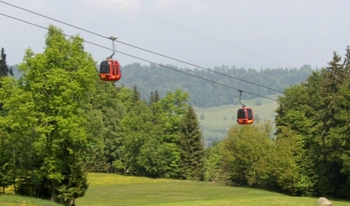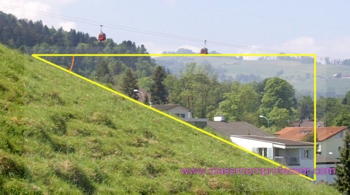Switzerland is known for its beautiful mountains and chocolate-box scenery, summer or winter. My wife and I were blessed to visit there this last spring, so I took the opportunity to video another podcast episode. We took a cable car up a smallish mountain near Lucerne; actually probably just a hill by Swiss standards, then walked down. We’d done this before on a higher mountains when we were younger and fitter, and ended up unable to walk the next day. So this time we were a bit wary of taking on too much.

So, what about the math in this setting? The cable car and the incredible mountains, and the road tunnels that go through them all got me thinking. The swiss have developed an impressive network of roads that enable a driver to travel all over the country, in spite of the mountains that threaten to prevent travel due to their sheer size and their steep slopes.
To cater for this steep topology, Swiss engineers have put in place cable cars, modified railways, tunnels and myriad other installations to respond to the terrain. Sloped paths, steps, zig-zag roads and a thousand other examples allow life to happen in among the mountains.
Here is the video. It includes a montage of varied shots of the cable car we rode on, and at the end there is an overlay of the angle of the slope itself (my apologies that the overlay doesn’t fit the slope very well – it’s an artifact of the video editor I use, due to changing from 16:9 to 4:3 aspect ratio, if you are familiar with video editing you’ll understand).
If you are interested, here is an interactive Google Earth view of the location where I shot the video:
So, back to the math. In geometry or space lessons, we teach about slope and angle, which can often be rather a dry topic without a real-life application. The slope of a ramp, a steep road, the cable for a cable car, are all such applications. Using a few simple props, your students can measure slopes and apply mathematics to analyse them and measure their stats. This can then be linked to:

- slope expressed as a ratio (eg, 1:8 – I remember these from when I was a child)
- slope as a percentage (eg, 12% – the more modern style)
- the angle of the slope
- the tangent of the angle, or the sine or cosine
Cross-curricular links could then be made to topics such as:
- mechanical advantage in a certain slope (how much easier is it to move up one slope compared to one with a different angle?)
- technology and engineering of building ramps, tunnels, cable systems, and so on
- environmental aspects of sloped land, such as erosion
- ‘optimal slope’ for certain purposes, such as driving a vehicle, mowing a sloped paddock, walking, etc.
- aesthetic aspects of hilly or mountainous country, when compared to flat land (How does the scenery make you feel? Why do people like to take vacations in the mountains?)
What do you teach about mountains in your curriculum? Could you incorporate slope in applied lessons with your students? Please leave a comment below – I’d love to hear your thoughts.
Till next week…
